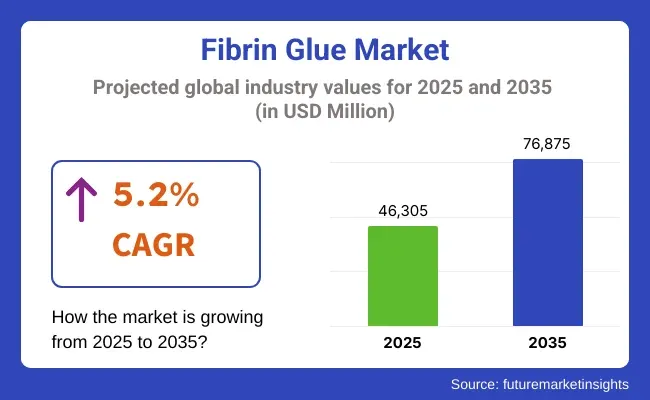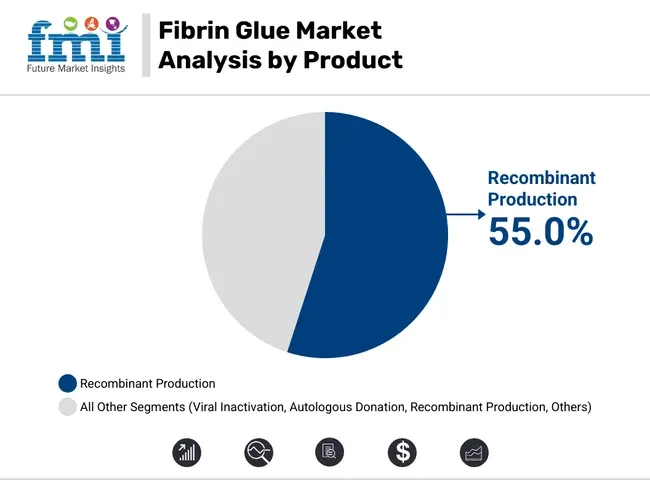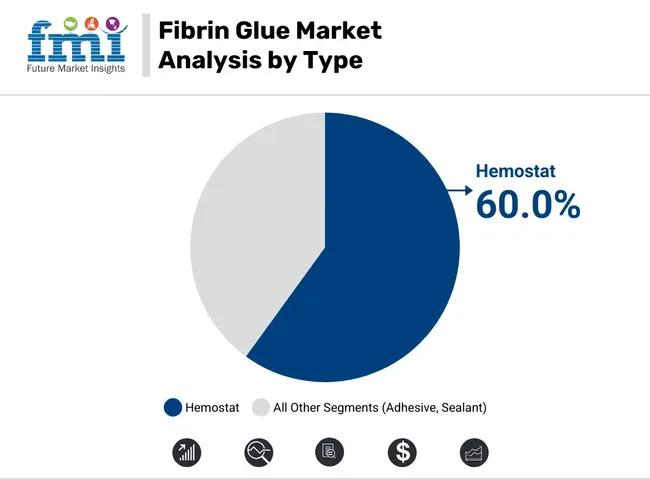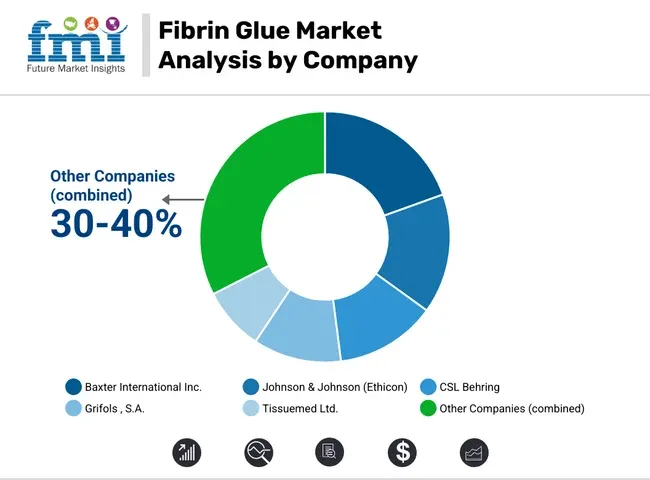The fibrin glue market is set to grow from USD 46,305 Million in 2025 all the way to USD 76,875 Million by 2035. The yearly growth rate is 5.2% during this time. This increase is due to more surgeries being done, more people knowing about less invasive treatments, and more long term illnesses needing surgery. All these factors will help the market grow and expand.

| Metric | Value |
|---|---|
| Market Size (2025E) | USD 46,305 Million |
| Market Value (2035F) | USD 76,875 Million |
| CAGR (2025 to 2035) | 5.2% |
The market for fibrin glue is set to grow a lot from 2025 to 2035. This is because more people are using fibrin sealants in surgery. Advances in tissue repair and the need for agents to stop bleeding in emergencies also help this market. Fibrin glue, made from human or animal blood, is popular in heart, bone, and plastic surgeries. This is due to its safe use with the body and its great help in healing wounds.
The fibrin glue market is growing fast because more surgeons use fibrin-based adhesives in surgeries, trauma cases, and wounds. Recombinant Production is the top product type due to lower risk of virus spread and better fit with the body. For how it's used, Hemostat is the top choice because it stops bleeding during surgery and trauma cases.
Market Share by Product (2025)

| Product | Market Share (2025) |
|---|---|
| Recombinant Production | 55.0% |
The Recombinant Production division has a 55% market share. This is due to its safety benefits. It avoids risks from human plasma and improves stop-bleeding traits. More use of biotech-made fibrin glue in surgeries has boosted demand, especially for heart, bone, and general surgeries.
Also, steady improvements in recombinant tech, better mixes, and longer shelf life are helping market growth. The move to bioengineered options and green lights for new recombinant fibrin glue are pushing more use.
Market Share by Type (2025)

| Type | Market Share (2025) |
|---|---|
| Hemostat | 60.0% |
The Hemostat segment accounts for 60% of the market as fibrin glue is imperative in attaining hemostasis in intricate surgical procedures. The increasing incidence of cardiovascular diseases, oncologic surgeries, and traumatic injuries is driving the demand for sophisticated hemostatic agents.
The market is witnessed to get lucrative growth due to the perseverance of the surgeons as they adopt fibrin-based hemostats for operations that will result in operative blood loss and post-operative recovery. Market growth is also driven by novel developments including sprayablehemostatic agents, combination products with thrombin, and biodegradable hemostatic agents.
High Production Costs and Risk of Viral Contamination
A big problem in the fibrin glue market is the high cost to make and clean fibrin adhesives. Fibrin glue comes from human or animal blood, which can carry viruses. This means it needs strict checks and high standards. These things make it hard to sell fibrin glue, especially where people need low-cost options.
Advancements in Biotechnology and Synthetic Alternatives
Advancements in technology including biotechnology and tissue engineering has huge scope of market growth for fibrin glue. Synthetic and recombinant fibrin sealants with more favorable safety profiles and stronger adhesion characteristics are in development. Moreover, the growing investment in regenerative medicine and bioengineered tissue adhesives will drive innovations in the fibrin glue market, broadening its application areas beyond surgical use.

The fibrin glue market in the USA grows as more people want better ways to heal wounds and seal surgery cuts. More doctors now use fibrin glue to stop bleeding. This glue is used a lot in heart, bone, and rebuilding surgeries. The FDA checks these products to make sure they work well and are safe.
Key trends include more use of fibrin glue that's made from natural sources. Easy surgery methods are getting more advanced, and there's increased study into healing with fibrin glue. The glue is being used more in dental and eye surgeries, adding to its growing market.
| Country | CAGR (2025 to 2035) |
|---|---|
| USA | 5.3% |
The fibrin glue market in the UK keeps growing. More people are using fibrin sealants in surgeries. Awareness of better blood-stopping solutions is rising, and there's a growing need for tissue glue made by science. The MHRA makes sure these medical adhesives are safe and work well.
Market trends show more use of fibrin glues in trauma care. Researchers look into synthetic options more now. There's also a bigger role for fibrin sealants in robot-assisted surgeries. Plus, government efforts for new wound care solutions boost market growth.
| Country | CAGR (2025 to 2035) |
|---|---|
| UK | 5.1% |
The fibrin glue market in Europe is booming. Rules there push use of safe, body-friendly medical glues. Many want fibrin-based agents for stopping bleeding. Use in tummy surgeries is also up. The EMA and EC keep the market safe and meeting top standards.
Germany, France, and Italy are top players. High surgery numbers, strong health systems, and wide use of fibrin glue help. Big trends include liking self-made fibrin sealants, growing use in skin grafts, tissue works, and more money in safe, break-down-glues for surgery.
| Region | CAGR (2025 to 2035) |
|---|---|
| European Union (EU) | 5.2% |
In Japan, the market for fibrin glue is growing. Advanced work in bio-glues, higher need for small surgery cuts, and more use in bone and brain care boost this market. The Ministry of Health oversees the growth and use of these medical glues.
More people are using fibrin glues in fixing old tissues and cells, more being used for long-term sore care, and a stronger focus on safe, body-friendly surgery glues. Also, Japan's rising older population needs better blood-stopping aides for elderly care.
| Country | CAGR (2025 to 2035) |
|---|---|
| Japan | 5.2% |
The market for fibrin glue in South Korea is growing fast. This growth is due to better healthcare, more use of fibrin sealants in beauty and rebuild surgeries, and focus on wound care. The MFDS controls the rules for surgical glues and biomaterials.
Market trends show more use of fibrin sealants for burns, new studies on better types of bioadhesives, and more use in robot surgeries. Also, South Korea is spending more on regenerative medicine, which increases the need for fibrin glue products.
| Country | CAGR (2025 to 2035) |
|---|---|
| South Korea | 5.2% |
The fibrin glue market is showing growth owing to high demand for effective surgical sealants, biocompatible adhesives, hemostatic agents used in medical and veterinary applications. Increasing surgical procedures, developments in regenerative medicine and a rise in preference for minimally invasive procedures contribute to the market growth.
The companies have developed high-efficacy fibrin sealants, formulation of improved clotting, and biologically derived adhesives for more efficient wound closure, tissue sealing, and enhanced recovery post-surgical procedures. Top biopharmaceutical companies, medical device companies, and biotechnology companies working in the field are contributing inventions beyond synthetic-free silk fibrin glues, enabling rapid polymerization adhesives, and advancing shelf-stable formulations.

Baxter International Inc. (20-24%)
Baxter leads the fibrin glue market, focusing on high-efficacy hemostatic sealants for diverse surgical applications.
Johnson & Johnson (Ethicon) (15-19%)
Ethicon specializes in advanced surgical adhesives, with a strong emphasis on cardiovascular and orthopedic use cases.
CSL Behring (12-16%)
CSL Behring develops biologically derived fibrin-based hemostatic solutions with rapid clotting properties.
Grifols, S.A. (10-14%)
Grifols enhances synthetic-free fibrin adhesives for wound care and trauma applications.
Tissuemed Ltd. (6-10%)
Tissuemed offers innovative fibrin-based tissue adhesives with a focus on neurosurgical applications.
Other Key Players (30-40% Combined)
Several biopharmaceutical firms, medical device manufacturers, and specialized adhesive companies contribute to advancements in fibrin glue technology. These include:
The overall market size for the fibrin glue market was USD 46,305 Million in 2025.
The fibrin glue market is expected to reach USD 76,875 Million in 2035.
Increasing surgical procedures, rising demand for hemostatic agents, advancements in regenerative medicine, and growing adoption of fibrin sealants in wound healing and tissue sealing will drive market growth.
The USA, Germany, Japan, China, and France are key contributors.
The surgical hemostasis segment is expected to lead due to its effectiveness in reducing bleeding, improving wound closure, and minimizing post-operative complications.






Full Research Suite comprises of:
Market outlook & trends analysis
Interviews & case studies
Strategic recommendations
Vendor profiles & capabilities analysis
5-year forecasts
8 regions and 60+ country-level data splits
Market segment data splits
12 months of continuous data updates
DELIVERED AS:
PDF EXCEL ONLINE
Fibrin Degradation Product (FnDP) Assays Market
Glue Machine Market by Product Type, Machinery Type, End Use Type & Region - Forecast 2025 to 2035
Market Share Distribution Among Glue Machine Suppliers
Wet Glue Labelling Machines Market
Automatic Glue Machine Market Size and Share Forecast Outlook 2025 to 2035
Ocular Sealants and Glues Market

Thank you!
You will receive an email from our Business Development Manager. Please be sure to check your SPAM/JUNK folder too.
Chat With
MaRIA